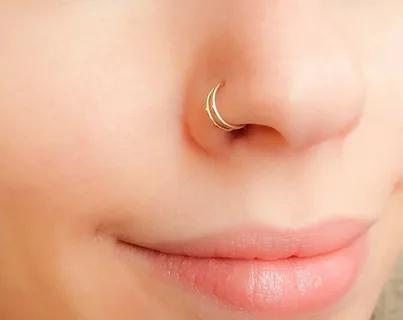Professional Tips to Fix a Nose Ring That’s Sinking Into Your Skin
A sinking nose ring is a common issue that can occur when the jewelry begins to embed into the skin. This is often due to improper jewelry size, swelling, or even poor aftercare. If left untreated, it can lead to complications such as infections or scarring. This guide provides actionable, professional tips to help you fix a nose ring that’s sinking into your skin, as well as preventive measures to avoid this problem in the future.
Why Does a Nose Ring Sink Into the Skin?
Understanding why a nose ring sinks into the skin is crucial to addressing the problem effectively. Several factors can cause this issue, ranging from poor jewelry choices to improper aftercare, or even a body’s natural response to the foreign object.
Improper Jewelry Fit and Its Role in Sinking
One of the primary reasons for a nose ring sinking into the skin is an improper jewelry fit. Jewelry that is too small or tight puts pressure on the skin, leading to embedding. Nose rings need to be the right size for the healing stage and should not be too snug. This is particularly important for newly pierced noses, as the tissue around the piercing will swell in the initial stages of healing. Using slightly larger jewelry can accommodate this swelling and prevent sinking.
Swelling and Inflammation Causing Sinking
Swelling is another leading cause of a nose ring sinking into the skin. When the area around the piercing becomes inflamed, it can push the jewelry deeper into the tissue. This is often due to irritation or an allergic reaction to the metal. It’s essential to manage swelling early by using hypoallergenic materials like titanium or surgical steel and following proper aftercare routines.
How Can You Prevent a Nose Ring From Sinking?
Prevention is key to avoiding a sinking nose ring. By following the right aftercare practices and making thoughtful decisions about your piercing, you can greatly reduce the chances of experiencing this issue.
Choosing the Right Jewelry for Your Nose Piercing
To prevent a nose ring from embedding into the skin, you must choose the appropriate jewelry. Opt for materials like titanium or surgical steel, which are less likely to cause allergic reactions or irritation. Additionally, ensure that the size of the jewelry is suitable for the healing stage. For new piercings, it’s recommended to use slightly larger jewelry to accommodate swelling.
If the jewelry is too tight, it can cause pressure, leading to sinking. Loose jewelry, on the other hand, might encourage piercing migration. Your piercer should help you select the right fit to ensure proper healing.
Aftercare Tips to Prevent Sinking
Proper aftercare is vital in ensuring your piercing heals without complications. Clean your nose piercing with a saline solution twice a day to reduce the risk of infection. Avoid using alcohol or hydrogen peroxide, as these can dry out the skin and irritate the piercing. Additionally, resist the urge to touch or twist your jewelry excessively, as this can cause irritation, leading to swelling or migration.
How to Fix a Nose Ring That’s Sinking Into Your Skin
If you’ve noticed that your nose ring is sinking, it’s important to act quickly to prevent further damage. While some cases can be managed at home, others may require professional intervention.
1. Switch to a Larger Jewelry Size
If the jewelry is too tight, it may be causing the piercing to sink. Switching to a larger piece of jewelry can relieve pressure and give your piercing more room to heal. Consult a professional piercer to ensure that the new jewelry is properly sized and made of hypoallergenic materials like titanium or surgical steel.
2. Reduce Swelling with Cold Compresses
To address swelling, which is a major contributor to a sinking piercing, use cold compresses or ice packs wrapped in a cloth to reduce inflammation. You can also take over-the-counter anti-inflammatory medications like ibuprofen to help reduce swelling. Reducing the inflammation can often cause the piercing to return to its normal position.
3. Clean the Piercing Properly
Keeping your piercing clean is essential to avoiding infections, which can worsen the issue. Use a saline solution to gently cleanse the area twice a day. Avoid harsh chemicals like alcohol or hydrogen peroxide, as these can irritate the skin and slow the healing process. Proper cleaning can help reduce swelling and prevent further embedding of the nose ring.
4. Consult a Professional Piercer
If the nose ring is severely embedded or home remedies don’t seem to help, it’s time to seek professional advice. A professional piercer can assess the situation and may recommend removing the jewelry or switching to a larger piece. In some cases, medical treatment may be necessary if the piercing is infected.
When Should You Seek Professional Help for a Sinking Nose Ring?
While mild cases of a sinking nose ring can often be treated at home, more severe cases require professional care. If you notice signs of infection, such as pus, excessive redness, or prolonged swelling, it’s essential to consult a professional piercer or healthcare provider immediately. They can assess the damage and take steps to prevent further complications, such as scarring or the need for surgery.
Conclusion
Dealing with a nose ring that’s sinking into the skin can be frustrating, but following these professional tips can help resolve the issue. Whether it’s switching to a larger piece of jewelry, reducing swelling, or seeking professional help, the right approach will ensure that your piercing heals properly. Always prioritize aftercare to avoid embedding and consult a piercer when necessary.
FAQs
What causes a nose ring to sink into the skin?
A nose ring may sink due to improper jewelry size, swelling, or incorrect aftercare. Tight jewelry often causes pressure, leading to embedding.
Can I fix a sinking nose ring at home?
In some cases, you can fix a sinking nose ring by switching to a larger piece of jewelry and reducing swelling with cold compresses. However, severe cases require professional help.
When should I see a piercer for a sinking nose ring?
If the nose ring is severely embedded, causing pain, or showing signs of infection, consult a professional piercer immediately.
What type of jewelry should I use to prevent sinking?
Use hypoallergenic materials such as titanium or surgical steel, and ensure the jewelry is the right size to accommodate swelling.
Can swelling cause a nose ring to sink?
Yes, swelling around the piercing can push the jewelry deeper into the skin, causing the nose ring to sink. Reducing swelling is essential to fixing the problem.
Is it safe to remove a sinking nose ring myself?
No, it’s best to consult a professional piercer before removing the jewelry, as improper removal can lead to infection or scarring.
How often should I clean my nose piercing?
Clean your nose piercing twice a day with a saline solution to prevent infection and promote healing.
Can infection cause a nose ring to sink?
Yes, infections can cause swelling and tissue damage, leading to the sinking of the nose ring. Seek medical advice if you suspect an infection.
What should I do if my nose ring is infected and sinking?
Clean the piercing with a saline solution and consult a professional or doctor for appropriate treatment.
Can a larger nose ring fix a sinking piercing?
Yes, switching to a larger nose ring can relieve pressure on the tissue and prevent further embedding.





